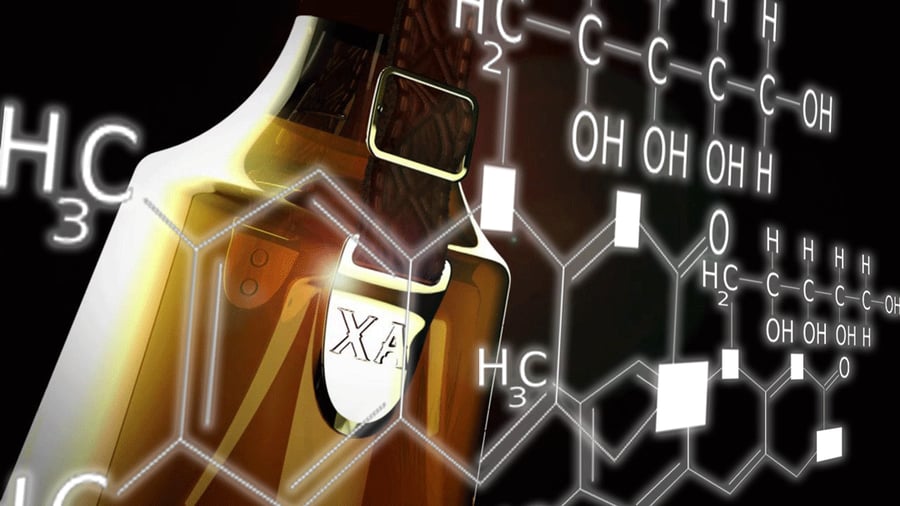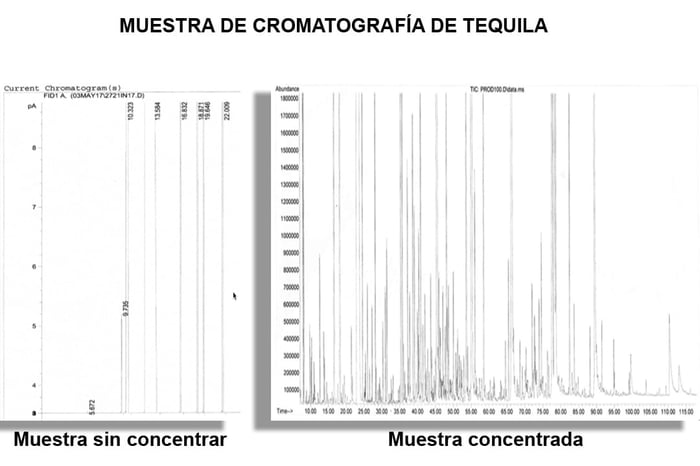
Tequila is a spirit drink obtained from distilling the fermented musts of cooked agave juices. Its chemical composition is approximately 99% a mixture of alcohol (ethanol) and water; however, the remaining 1% is what makes the difference.
Tequila Chromatographic Fingerprint
When one reviews the tequila standard (NOM-006-SCFI-2012), it indicates around a dozen compounds to follow. However, more than a hundred compounds are observed when analysis tests are performed on where the compounds are concentrated.
This is wonderful and is similar to when one observes a drop of water through a microscope and can see how something so simple is transformed through the lens into something so complex and diverse.
In the following images, you can see these facts.

Can you make synthetic tequila?
I once read in a journal that American scientists identified and quantified around 160 compounds in a tequila. They then prepared a solution with the same components and in the same concentrations.
They tried to prepare a synthetic drink based on the chemical composition of tequila. The result was a bit frustrating since the organoleptic characteristics could not match the original tequila.
What happened? 160 compounds and could not match the original tequila. How was this possible?
How many chemical compounds does tequila have?
As a Chemist, and in my experience, I can tell you that the original tequila, the object of study, is not made up of only 160 compounds. There are many more compounds that make it up.
At Casa Sauza, one of the main objectives is to establish sensory profiles not only for tequila as a final product but also for each intermediate product (by-products) in each of the process stages.
Methodology for the chemical analysis of tequila.
Establishing sensory profiles may seem simple; however, it is hard work that requires specialized technical knowledge of those who do it. It is very important to know the analysis techniques and their scope and limitations.
The most widely used technique for this application is gas chromatography with mass spectrometry. Gas chromatography separates the compounds that make up the sample, in our case, tequila. Once the compounds have been separated, they are identified and quantified by mass spectrometry.
As I mentioned at the beginning of this article, it is essential to concentrate the compounds using an extraction technique. The most commonly used method is liquid-liquid extraction. In this, an organic solvent immiscible with tequila is used, both shaken vigorously in a separatory funnel. Once the compounds have migrated to the organic solvent, it is evaporated in a special device, making it possible to concentrate the compounds.
Utilities of knowing the chemical/sensory profiles of tequilas
- In the case of impurity, the differences between authentic and fake tequila can be categorically shown.
- Each tequila-producing company may establish chemical/aromatic standards for each tequilas.
- In the case of reposados, añejos, and extra añejos tequilas, the actual degree of aging can be known; that is, the chemical/aromatic contribution that the wood makes to the tequila can be known.
Challenges of chemical/sensory profiles in tequilas
Finally, it is worth mentioning that this technique is not exclusive to tequila. It can be applied to any alcoholic beverage, and even better, it can be used to monitor each of the by-products generated in each of the alcoholic beverage production stages.
We invite you to come to Casa Sauza and learn more about our tequila production processes:
.png?width=50&height=50&name=10.CS-Redondo%20(1).png)
